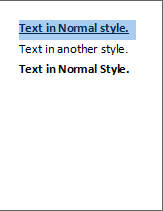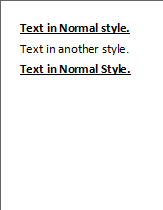17.7.4.2 autoRedefine
This element specifies whether an application shall automatically modify this style when the contents of an entire paragraph in the document with this style applied are modified, ensuring that although only a single instance of text with this style was modified, that change is stored on the style and therefore propagated to all locations where the style is in use.
If this element is omitted, then formatting shall not automatically be merged back into the style definition.
[Example: Consider a style defined as follows in a WordprocessingML document:
<w:style w:styleId="Normal" … >
<w:name w:val="Normal"/>
<w:autoRedefine/>
<w:rPr>
<w:b/>
</w:rPr>
…
</w:style>This style specifies via the use of the autoRedefine element that any formatting applied to text which uses this style must be merged back into the style definition (assuming, of course, that this is a paragraph style).
For example, consider a document which uses the Normal style as defined above:

The first and third paragraphs use the Normal style, and hence have the bold property applied. If an application were to add the underline formatting to the entire first paragraph, as follows:

That property, rather than being saved as direct formatting, must be used to update the associated Normal style to add this property, specified using the u element (17.3.2.40).
<w:style w:styleId="Normal" … >
<w:name w:val="Normal"/>
<w:autoRedefine/>
<w:rPr>
<w:b/>
<w:u/>
</w:rPr>
…
</w:style>Since this property is automatically merged into the style, it would also appear on the third paragraph (note that the step above would normally be automatically modified into the state shown below, and not discrete as shown above).

end example]
This element’s content model is defined by the common boolean property definition in 17.17.4.